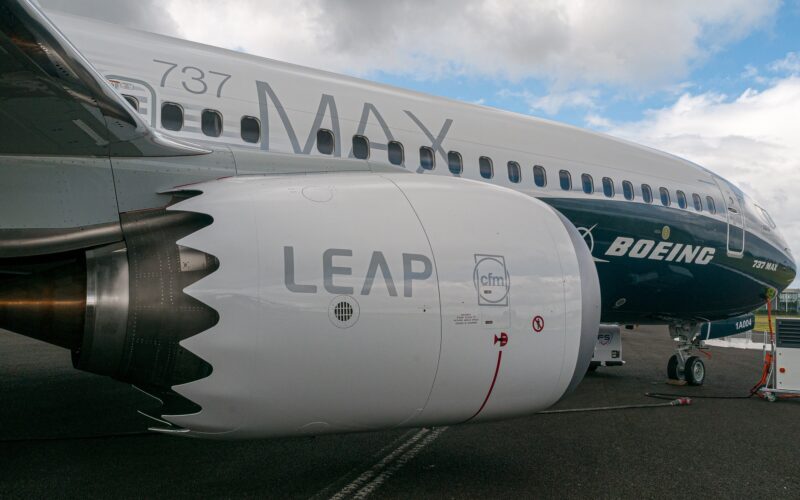The United States (US) Federal Aviation Administration (FAA) issued a final rule Airworthiness Directive (AD) for the Boeing 737 MAX, including the 737 MAX-8, MAX-9, and the high-density MAX-8-200, with the aim of preventing fuel tank explosions.
The final rule AD was published on April 5, 2023, and will come into effect on May 10, 2023.
In the AD, the FAA stated that the directive “was prompted by a determination that a new airworthiness limitation is necessary to require periodic replacement of the oxygen sensor of the nitrogen generation system (NGS)”. The notice of proposed rulemaking (NPRM) for the directive included a proposal to revise the current maintenance program and include the new airworthiness limitation.
“The FAA is issuing this AD to prevent increasing the flammability exposure of the center fuel tank, which together with an ignition source in the fuel tank, could lead to a fuel tank explosion and consequent loss of the airplane,” the agency said.
The AD affects 62 aircraft registered in the US, and the work to comply with the directive is expected to take airlines an average of 90 hours. However, the FAA said it “recognizes that this number may vary from operator to operator” and, as such, provided a per-operator cost estimate of $7,650, which will be comprised of 90 work hours at $85 per hour.
Affecting foreign operators
For exported 737 MAXs, the agency identified that the AD applies to all aircraft of the type “with an original airworthiness certificate or original export certificate of airworthiness issued on or before April 1, 2021”. Furthermore, the AD applies to aircraft with the Line Number (LN) 7668, 7678, and 7915.
According to ch-aviation.com data, LN 7668 is a 737 MAX-8 operated by Fiji Airways. It was delivered to the airline in May 2021 and is currently registered as DQ-FAE. Aeromexico, and was delivered to the Mexican airline in June 2021 under the registration XA-MAZ, while LN 7915 is a 737 MAX-9 configured as a Boeing Business Jet (BBJ). It was last seen in the skies in August 2021, flying from Boeing Field-King County International Airport (BFI), the site where it was built, to Keflavik Airport (KEF) in Iceland. The aircraft finally landed at EuroAirport Basel-Mulhouse-Freiburg (BSL) in France. It is registered as VP-BST.
Meanwhile, ch-aviation.com data shows that 848 737 MAX aircraft were built before March 31, 2021, and are associated with 73 different airlines. Out of those 848, 612 are currently active with 60 carriers across the globe.
Several of those airlines, including Boeing, American Airlines, SIA Engineering Company, a subsidiary of Singapore Airlines, and United Airlines, provided comments about the AD to the FAA. The regulator also noted that it had received comments from the International Air Line Pilots Association (ALPA) and “an individual who supported the NPRM without change”.
American Airlines, for example, requested that the agency “add a provision to accomplish the oxygen sensor replacement with a repaired or overhauled sensor instead of a brand new sensor”, easing the burden for operators since they would be able to reuse sensors without buying new ones. The FAA agreed with the request.
SIA Engineering Company asked the FAA to clarify which 737 MAX aircraft the directive applied to. The regulator agreed to the request, adding that the AD does not apply to any aircraft of the type that has not been specified by the FAA.
Boeing remarked that the NPRM for the AD included a sentence about the “degraded performance by the sensor could result in the [air separation module] ASM failing to produce nitrogen-enriched air, and the fuel tank becoming more flammable due to excessive oxygen-enriched air”. According to the manufacturer, this is incorrect, as it implies “a causality between a failing oxygen sensor and a degrading ASM, when there is none” and that if the ASMs begin to fail, oxygen enriched air (OEA) is redirected to the fuel tanks.
“While the FAA agreed that there “is no causality between the degraded performance of the oxygen sensor and failure of ASM”, the regulator said that it would not make changes to the directive because the sentence was not included in the final rule AD.”
United Airlines asked the agency to include the cost and part availability for the NGS oxygen sensor. The FAA denied the request, citing the fact that the “AD requires operators to revise their existing maintenance or inspection program, as applicable, to incorporate the new airworthiness limitations”.
The FAA concluded that the initial compliance time for accomplishing the Airworthiness Limitations (AWLs) related to the NGS is “within 18,000 flight hours after the date of issuance of the original airworthiness certificate or the original export certificate of airworthiness, within 18,000 flight hours after the most recent replacement or test was performed as specified in AWL No. 47–AWL–09, or within 12 months after the effective date of this AD, whichever is latest.”

